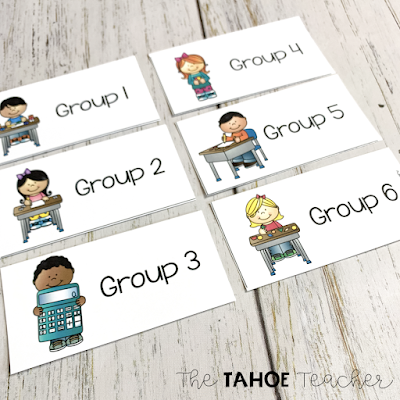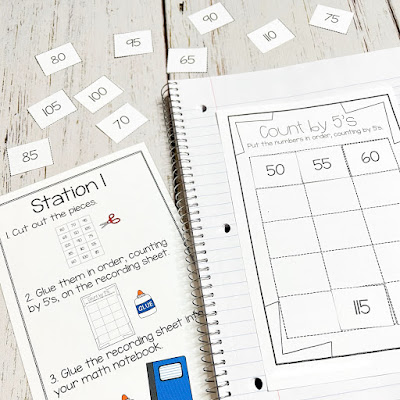Making Math Stations Work for You
Hey y'all! Have you taken the plunge and tried math stations yet? If you have, excellent! If you haven't, or you want to but aren't sure how to manage it, here's a few ideas on how it could work for you, but first, let's cover the basics.What:
Math stations are a set of 6 stations the kids go to throughout the week. If you're familiar with the way we set up science stations, this is very much the same setup. We typically have a whole group lesson on Monday, do 2 rotations a day on Tuesday through Thursday, and have a culminating activity on Friday. The whole time during rotations, I am walking around monitoring students, providing feedback, and making sure they are understanding the big ideas in each station.
To get our stations organized, I label each box with a number. Students are assigned a group and typically rotate through each center together, but not always as I'll show you below. These are shoebox sized plastic bins I picked up from Target, but you can find them anywhere.
Don't be afraid to mix things up either. If I see they're getting a little too comfortable together, I'll reassign groups. If they're off the charts awesome, I'll let them pick their partners for the week. You be the judge on what your students can handle.
Why:
Why should you try math stations? In my classroom, math and science stations are the most organized and engaging part of our whole day. The kids are excited, they know the routine without any prompts from me, they are independent in their learning, and I rarely have a student off task. This is the time of day when I hear, "This is the best day ever!" most frequently. The kids are LEARNING and they see it as play. It's a win-win.To get our stations organized, I label each box with a number. Students are assigned a group and typically rotate through each center together, but not always as I'll show you below. These are shoebox sized plastic bins I picked up from Target, but you can find them anywhere.
Who:
Keep your groups flexible. I assign my students groups based on how they interact with each other. I may pair a couple of struggling readers together if I know they can persevere and figure things out together, or if I know that I can help them both at the same time in that set of stations. I may pair a high kid and a low kid together if I know they can work well together. You know your kiddos. Set them up in groups that get along well together but won't get each other off task.Don't be afraid to mix things up either. If I see they're getting a little too comfortable together, I'll reassign groups. If they're off the charts awesome, I'll let them pick their partners for the week. You be the judge on what your students can handle.
How:
The "how" is flexible. More often than not, we do centers the way they are described above. But not all weeks are that organized. Sometimes we have an early release that cuts into our math time. Sometimes, we have special event that messes with our schedule. Whatever the reason, there are other ways to make it work.
Option 1: You have a four day week, so you can do the Monday whole group lesson on the first day of the week, then do 3 stations a day on the next two days, and the culminating lesson on the last day of the week.
Option 2: Do the Monday lesson on your first full math time of the week. Set up the centers on a day where you have a full hour and half or more and rotate through all 6. Then, do the Friday activity on the next full math day. This requires some stamina from your littles. I wouldn't use this setup at the very beginning of the year.
Option 3: Do the Monday lesson on a full math day. Setup all the centers on a day when you have a solid hour and half, but let them choose which ones to go to, how long to stay, and where to go next. Do the Friday experiment at the end of the week.
**I use this option with skills my students are already pretty strong in. I do not use this setup with content heavy units because I want to make sure they get to Every. Single. Station.
Option 4: With some skills, I knew my students were not ready to do stations independently. We did the Monday lesson whole group. The next day, we did 3-4 of the stations whole group. Wednesday and Thursday, students played the games from the stations we didn't do whole group in partners or groups of 3-4 while I talked with each group to make sure they knew how to apply the skill. And Friday we did the whole group culminating activity.
Option 5: Do one activity a day whole group. This isn't the same as stations, obviously, but if you have a class that just can't handle it then this might be your best bet for setting expectations.
I personally don't like doing it this way. Even my toughest classes were the best behaved during stations, so I am a HUGE advocate for rotations. However, you have to do what's best for your students and their learning styles.
Putting it all Together:
I hope I answered a few questions for you. I've heard many teachers say they love reading centers but are hesitant to try math stations because they've never taught it that way. If you're at that point right now, rest assured that it can be done and your students will love you for it. Teaching math this way has been SO MUCH FUN for both my students and me. I no longer have wiggly ones interrupting the whole group lesson because they can't sit still. The fast pace of the centers keeps them engaged and focused.
To grab a copy of the center organization signs, click here (it's free!). And stay tuned for more math units coming soon. Be sure to follow me on TPT to stay in the know about updates, ideas, and new resources. Have a great week and I'll talk to you soon.
To grab a copy of the center organization signs, click here (it's free!). And stay tuned for more math units coming soon. Be sure to follow me on TPT to stay in the know about updates, ideas, and new resources. Have a great week and I'll talk to you soon.
Stay cozy,







No comments
Post a Comment